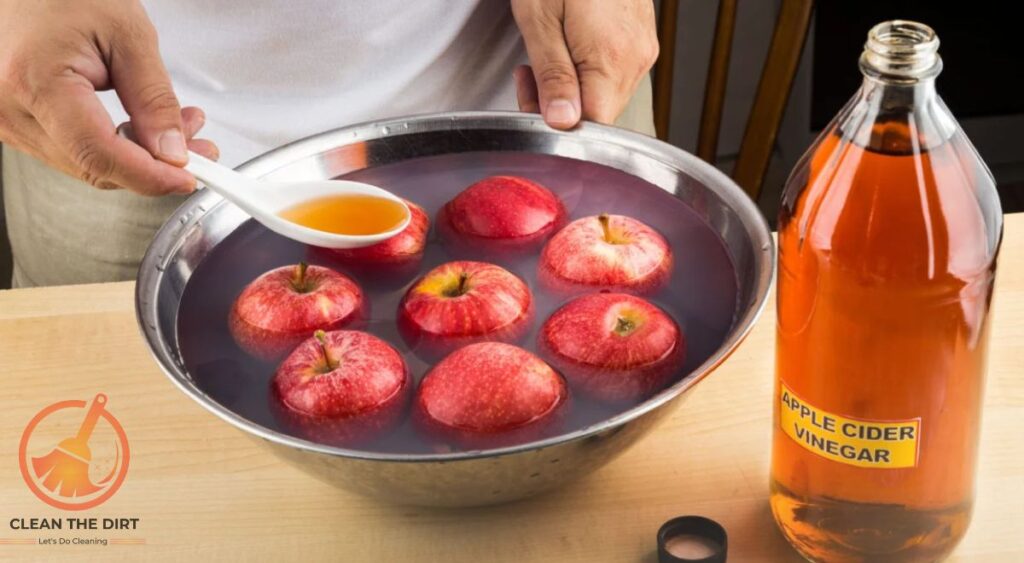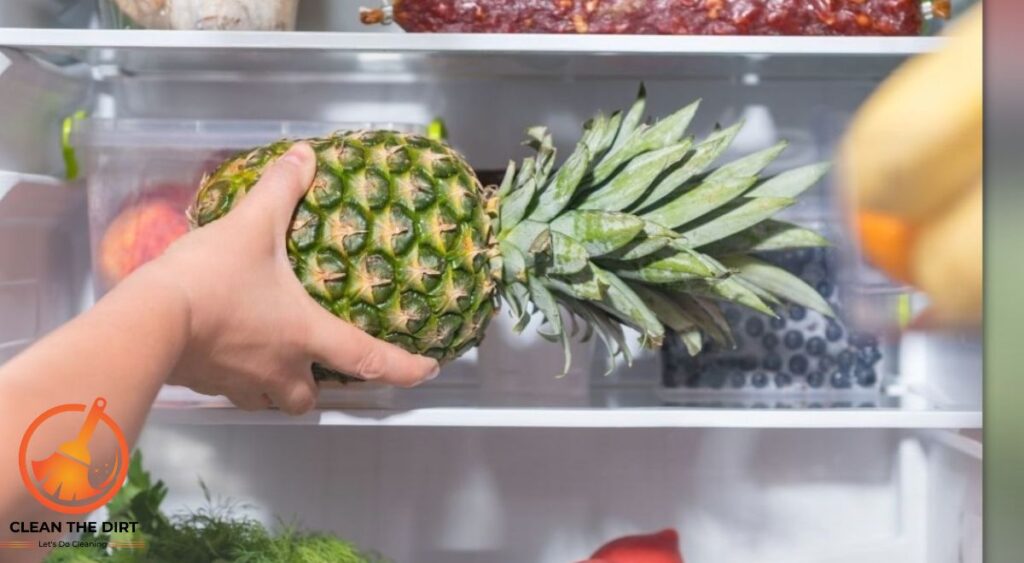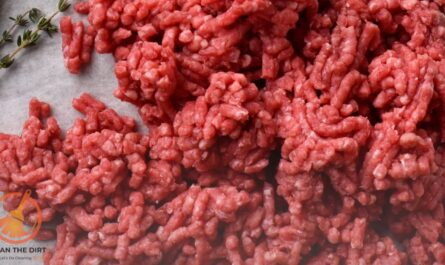Table of Contents
Introduction
Hello friends and welcome to the ultimate guide on how to clean fruit with baking soda and vinegar. This guide has emerged as a game-changing hack for health-conscious individuals. The days of just running fruit under the water tap are long gone, instead, we can now use a natural, efficient procedure that guarantees mental clarity in addition to cleanliness.
Imagine a plump, juicy apple glistening under the kitchen light, enticing you with its crispness. But wait, before you take that first bite, have you ever paused to consider what might be lingering on its surface? Pesticides, waxes, dirt, and even bacteria can hitch a ride on the fruits we love. That’s where our trusty duo, baking soda and vinegar, swoop in to save the day.
In this comprehensive guide on how to clean fruit with baking soda and vinegar, we’ll walk you through the step-by-step process of cleaning fruit with baking soda and vinegar, ensuring that every strawberry, every peach, and every grape you eat is not just delicious but also free from unwanted residues. So, grab your apron, and let’s embark on a journey to cleaner, safer fruit consumption.
Why Choose Baking Soda and Vinegar for Cleaning Your Fruit?
You may be asking yourself, “Why clean fruit with vinegar and baking soda when there are so many commercial cleaners out there?” The answer is found in the unmatched advantages these two culinary essentials provide.
1. Natural Powerhouses
Baking soda and vinegar are like the dynamic duo of natural cleaning. Baking soda, with its gentle abrasiveness, helps to scrub away dirt and residues, while vinegar’s acidic nature aids in breaking down pesticides and bacteria.
2. Effective Against Pesticides
Pesticides are a common concern when it comes to store-bought produce. However, studies have shown that the process in which we learn how to clean fruit with baking soda and vinegar is highly effective in removing pesticide residues, providing you with peace of mind and safer eating.
3. Gentle Yet Thorough Cleaning
Unlike harsh chemical cleaners, baking soda and vinegar offer a gentler approach to fruit cleaning. They effectively remove contaminants without leaving behind any harmful residues or altering the taste of your favorite fruits.
4. Environmentally Friendly
Opting for natural cleaning methods like baking soda and vinegar is not just good for your health but also good for the environment. You can reduce your carbon footprint by using fewer chemicals and relying on eco-friendly alternatives.

5. Cost-Effective
Let’s face it, buying specialized fruit cleaners can quickly add up. With baking soda and vinegar, you have affordable, multipurpose ingredients right in your kitchen. It’s a budget-friendly way to ensure your fruit is clean and safe to eat.
By utilizing the combined power of baking soda and vinegar, you can enjoy the fruits like cleaned strawberries and other fruits with confidence, knowing that you’ve given them the thorough cleaning they deserve. Now let’s move to the next section of the process of how to clean fruit with baking soda and vinegar which is a step-by-step guide.
How to Clean Fruit with Baking Soda and Vinegar? A Step-by-Step Guide
Now that you’re ready to embark on your fruit-cleaning journey, let’s dive into the simple yet effective process of how to clean fruit with baking soda and vinegar.
Step 1: Gather Your Supplies
First of all, gather your supplies. You’ll need:
- Baking Soda: This kitchen staple will be your main cleaning agent.
- Vinegar: Opt for white vinegar or apple cider vinegar for best results.
- Water: Fresh and clean water will help dilute the cleaning solution.
- A Bowl or Sink: A big container is required to accommodate the cleaning solution and your fruit.
Step 2: Create the Cleaning Solution
In your bowl or sink, mix water and baking soda together. Aim for a ratio of about 1 tablespoon of baking soda per gallon of water. Once the baking soda is dissolved, add a splash of vinegar. Be prepared for a fizzing reaction, that’s the magic happening.
Step 3: Soak the Fruits
Now comes the main part, soaking your fruits. Submerge your fruits in the cleaning solution, ensuring they’re fully covered. Let them soak for 10-15 minutes to allow the baking soda and vinegar to work their cleaning magic.
Step 4: Rinse Thoroughly
After the soaking period is up, it’s time to give your fruits a good rinse. Use cold running water to thoroughly rinse off any remaining baking soda and vinegar residue. You want your fruits to be squeaky clean.
Step 5: Dry the Fruits
Once rinsed, gently pat your fruits dry with a clean kitchen towel or let them air dry naturally. Avoid using heat to dry them, as this can cause them to lose moisture and freshness.
And that’s it, your fruits are now clean, fresh, and ready to enjoy. Incorporate this simple method which provides the knowledge on how to clean fruit with baking soda and vinegar into your routine for a healthier approach to snacking.
Safety Precautions and Considerations
While this guide on how to clean fruit with baking soda and vinegar is generally safe and effective, it’s essential to keep a few precautions in mind to ensure your health and the quality of your fruit.
1. Choose the Right Vinegar
When selecting vinegar for your cleaning solution, opt for food-grade white vinegar or apple cider vinegar. Avoid using highly concentrated kinds of vinegar, such as cleaning vinegar, as they may be too harsh for delicate fruits.

2. Dilute Properly
It’s crucial to dilute the baking soda and vinegar solution appropriately. Using too much baking soda or vinegar can leave a residue on your fruit or alter its taste. Follow the recommended ratios and guidelines provided above in this guide on how to clean fruit with baking soda and vinegar to avoid overdoing it.
3. Rinse Thoroughly
After soaking your fruits in the cleaning solution, be sure to rinse them thoroughly with cold running water. This step helps remove any remaining residues and ensures that your fruits are clean and safe to eat.
4. Check for Sensitivities
Some fruits may be more sensitive to acidic solutions like vinegar. Before cleaning all of your fruits with baking soda and vinegar, consider testing the solution on a small batch to ensure that it doesn’t cause any adverse reactions or affect the taste or texture of the fruit.
5. Pat Dry Gently
After rinsing your fruits, pat them dry gently with a clean kitchen towel or allow them to air dry naturally. Avoid using heat to dry them, as this can cause them to lose moisture and freshness.
By following these safety precautions and considerations, you can confidently incorporate this task of how to clean fruit with baking soda and vinegar into your routine. No matter you are cleaning apples with baking soda and vinegar or you are cleaning grapes, know that you’re taking the necessary steps to ensure clean, safe, and delicious fruit every time.
Additional Tips for Maintaining Clean and Fresh Fruit
Congratulations on mastering the art of how to clean fruit with baking soda and vinegar. Now that your fruits are sparkling clean, let’s explore some additional tips to help you maintain their freshness and quality for longer.
1. Proper Storage
After cleaning your fruits, it’s essential to store them properly to prevent spoilage. Consider storing fruits in the refrigerator, especially if they are prone to quick ripening. Use breathable containers or perforated bags to allow for air circulation and prevent moisture buildup.

2. Wash Before Eating
While cleaning fruit with baking soda and vinegar effectively removes surface contaminants, it’s still a good idea to give your fruits a quick rinse under cold water just before eating them. This extra step helps ensure that any remaining residues are washed away before consumption.
3. Handle with Care
Treat your fruits with care to avoid bruising or damaging them, which can accelerate spoilage. When handling delicate fruits like berries or grapes, gently transfer them to avoid crushing or bruising.
4. Rotate Your Stock
To prevent fruits from going bad before you have a chance to enjoy them, practice rotating your stock regularly. Use older fruits first and refill your supply with fresh ones to ensure a constant rotation of ripe, ready-to-eat fruit.
5. Explore Other Natural Cleaning Methods
While cleaning fruit with baking soda and vinegar is effective, don’t be afraid to explore other natural cleaning methods as well. Lemon juice, salt water, and commercial fruit washes are all viable alternatives worth trying.
By incorporating these additional tips mentioned in this guide on how to clean fruit with baking soda and vinegar, you can prolong the freshness and quality of your fruits, ensuring a delicious and nutritious snack every time you reach for them.
Conclusion
Congratulations on completing this ultimate guide on how to clean fruit with baking soda and vinegar. By now, you’ve learned the ins and outs of using the natural cleaning power of these kitchen staples to ensure your fruits are not just clean but also safe to eat.
With each step of the process of how to clean fruit with baking soda and vinegar, from creating the cleaning solution to properly storing your fruits after cleaning, you’ve taken proactive measures to prioritize your health and well-being. By choosing natural cleaning methods like baking soda and vinegar, you’ve not only eliminated harmful residues but also contributed to a healthier environment.
So, the next time you reach for an apple, a bunch of grapes, or a handful of berries, you can do so with confidence, knowing that you’ve given them the thorough cleaning they deserve. Incorporate the tips, tricks, and precautions you’ve learned into your fruit-cleaning routine, and watch as your snacks become not just tastier but also safer.
Remember, the journey to cleaner, healthier eating begins with small, simple steps. By embracing natural solutions like baking soda and vinegar, you’re taking a step in the right direction toward a more mindful approach to food consumption.
Discovering the best method for cleaning your fruit is crucial for ensuring both safety and flavor. In this comparison, we pit natural household staples, baking soda and vinegar, against commercial fruit cleaners.
| Aspect | Baking Soda and Vinegar | Commercial Fruit Cleaners |
|---|---|---|
| Ingredients | Natural, household staples (baking soda, vinegar) | Chemical-based formulations |
| Effectiveness | Effective at removing residues, pesticides, and bacteria | Also effective, but may contain harsh chemicals |
| Safety | Generally safe, natural ingredients | May contain potentially harmful chemicals |
| Cost | Economical, ingredients are typically already available | Can be more expensive, especially with frequent use |
| Environmental Impact | Environmentally friendly, biodegradable ingredients | May contain non-biodegradable or harmful chemicals |
| Taste and Residue | Minimal residue, does not significantly alter taste | May leave residue or chemical taste on fruits |
| Availability | Easily accessible, commonly found in households | Available for purchase in stores or online |
Thank you for joining us on this journey of how to clean fruit with baking soda and vinegar, for safer fruit consumption. Here’s to many more delicious, nutritious snacks in your future.
Frequently Asked Questions (FAQs) For How to Clean Fruit With Baking Soda and Vinegar?
Is it safe to clean fruit with baking soda and vinegar?
Yes, it is generally safe to clean fruit with baking soda and vinegar. Both ingredients are natural and effective at removing contaminants from the surface of fruits.
Do I need to rinse my fruits after cleaning them with baking soda and vinegar?
Yes, it’s important to rinse your fruits thoroughly with cold water after cleaning them with baking soda and vinegar. This helps remove any remaining residues and ensures they are safe to eat.
Can I use any type of vinegar for cleaning fruit?
It’s best to use food-grade white vinegar or apple cider vinegar for cleaning fruit. Avoid using highly concentrated or industrial-grade kinds of vinegar, as they may be too harsh for delicate fruits.
How long should I soak my fruits in the baking soda and vinegar solution?
It’s recommended to soak your fruits for 10-15 minutes in the baking soda and vinegar solution to ensure thorough cleaning. However, you can adjust the soaking time based on the type and condition of the fruit.
Will cleaning fruit with baking soda and vinegar alter its taste?
When used in the proper dilution, baking soda and vinegar should not significantly alter the taste of the fruit. However, it’s important to rinse the fruit thoroughly after cleaning to remove any residues.
Are there any fruits that should not be cleaned with baking soda and vinegar?
While most fruits can be safely cleaned with baking soda and vinegar, some may be more sensitive to acidic solutions. It’s a good idea to test the solution on a small batch of fruits before cleaning all of them.
Can I store fruits after cleaning them with baking soda and vinegar?
Yes, you can store cleaned fruits in the refrigerator to maintain their freshness and quality for longer. Be sure to store them properly in breathable containers or perforated bags to prevent spoilage.
You May Also Like: How to Clean Berries With Vinegar? Expert Tips and Tricks




